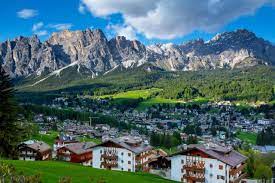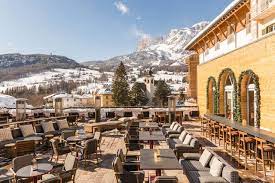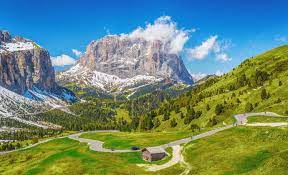This small town in Italy is called the ‘Queen of the Dolomites’

Elizabeth Heath
Rome: It’s not like there are bad places to go in the Italian Dolomites, but a few areas seem to have a little something extra — a more dramatic position amid the mountain ranges, a closer proximity to the slopes, a chicer culinary scene, a more exclusive vibe, and just a wee bit more of that heart-stopping beauty. Almost unfairly, Cortina d’Ampezzo has all of these advantages and more. Long one of Italy’s most exclusive destinations for winter vacations, it’s also regularly on lists of the best ski resorts in Europe and best small towns in Italy. And it’s getting ready to relive its glory days as it gears up, along with Milan, to host the 2026 Winter Olympics, a redux of the 1956 games that put Cortina on the international ski map.

Known as the “Queen of the Dolomites” (or the “Pearl of the Dolomites”), Cortina d’Ampezzo today is a posh resort on the Dolomiti Superski circuit, the world’s largest ski area with more than 745 miles of pistes. It attracts adventurers with mountain biking, hiking, and climbing, as well as those looking for calmer pursuits, like Michelin-starred dining, high-end shopping, and a glamorous après-ski scene. To top it off, Cortina provides visitors with plenty of cushy hotels, including some of the Dolomites’ most revered properties.
D Hotel Savoia: This updated landmark property is right near the center of town, and has a spa, family-friendly suites, and a guest book chock-full of A-listers. The largest resort in the Ampezzo Valley, the Savoia also offers the Radisson Residences Savoia Palace, an apartment hotel suited to longer stays.
Faloria Mountain Spa Resort: This woodsy, contemporary resort is a favorite for Travel + Leisure A-List advisors Andrea Grisdale and Stefano Sancassani of IC Bellagio, especially when they’re booking for couples. “When it comes to romance, there is no better place than their penthouse suite,” says Grisdale.

Rosapetra Spa Resort: Hugged by mountains and meadows, a short distance from Cortina’s busy centro, Rosapetra has just 33 rooms and seven suites, all done in natural wood for a rustic-minimalist effect. While the resort welcomes families, it has an adult feel, best experienced in its hushed spa.
Cristallo Resort & Spa: When art nouveau grand dame Cristallo Resort & Spa emerges from hibernation in late 2024, it will be rebranded as a Mandarin Oriental — the group’s first alpine resort — in plenty of time to welcome guests for the 2026 Olympics.
Swoosh around Dolomiti Superski: With more than 745 miles of slopes and 120 modern lifts and cable cars that connect passholders to the entire network, the world’s largest ski circuit ensures visitors won’t ever get bored. In the summertime, those same hills are alive with glorious hiking and biking among high mountain meadows and pristine lakes.
Explore the Tre Cime di Lavaredo: The Dolomites’ toothiest peaks look foreboding, but they’re actually remarkably accessible, even for the moderately fit, via a 6.4-mile trail that skirts the base of the mountains. The incredibly scenic hike takes about 3.5 hours, or more if you stop for lunch at a cozy rifugio.
IC Bellagio recommends hiring a guide and tackling a via ferrata at the Cascate di Fanes, a crashing waterfall in the Natural Park of the Ampezzo Dolomites. “It’s a very pleasant excursion in an impressive landscape, combining views with an easy itinerary suitable also for beginners on the rocks,” says Sancassani.
You don’t have to ski or hike to access Cortina’s epic landscapes. From town, take the Freccia nel Cielo cable cars up to the Cima Tofana, the third-highest peak in the Dolomites, for mozzafiato (breathtaking) views at 10,640 feet. Enjoy some pizza at nearly two miles high, then get whisked back down to Cortina.
Helmed by chef Federico Rovacchi, who spent six years at three-Michelin-starred St. Hubertus in San Cassiano, Baita Piè Tofana chalet earns top marks from Grisdale. “It’s the ideal place to escape the city in summer, and a relaxing hideaway in winter during a ski day on the Tofana mountains.”
Tivoli: The stunning surroundings at Tivoli, paired with exquisitely labored-over plates of colorful cuisine, helped Cortina earn a spot on T+L’s list of the best ski towns to visit for Michelin-starred dining. Reserve early to snag a table inside with a view or, weather permitting, out on the patio.
Pontejel Bierstube Forst: The decor is bright and simple, and the hearty Tyrolean menu is a reminder of how close you are to the Austrian border. Located right in the center of Cortina, this cheerful tavern is an easy pit stop for a cold beer, a soft pretzel, and a platter (or tagliere) of regional charcuterie.
Artigianato Artistico Ampezzano: Cortina is home to centuries-old craft traditions, including furniture making, deer antler carvings, and highly specialized tarkashi wooden objects inlaid with metal. Find jewelry, homewares, Christmas ornaments, gifts, and more at this artisan store, which has two locations in town.
La Cooperativa di Cortina: You won’t find many places in Italy like this multilevel shopping mecca, which brings together scores of products and services under one roof. Shop clothing, gifts, made-to-measure furnishings, regional crafts, and artisanal foods. A personalized pet sweater, a Marshall speaker, Timberland boots, and a YSL fragrance? Yes, they’ve got all of that.
Franz Kraler: Whether you’re kitting up for the slopes or just to cut a figure during après-ski, Franz Kraler has you covered. Grisdale refers clients here for the luxury boutique’s “outstanding service” and hallowed Italian brands like Prada, Gucci, Fendi, and Versace, plus premium sportswear from Moncler, Gamme Rouge, and White Label.
Enoteca Cortina: When he’s in Cortina, Sancassani heads to this beloved wine bar to sample from founder Gerry’s extensive cellar. “He has collected select wines from the best growing regions worldwide, stored them well, and is happy to share a good drop with his guests,” says Sancassani. Per Italian tradition, your glass will come with a small plate of appetizers.
Restaurant Col Drusciè 1778: Grisdale likes to wow guests at this mountainside restaurant, which can be reached by gondola or human power. It features “awe-inspiring” views from its lawn and terrace, and on select nights, you can follow dinner or drinks with a visit to the adjacent observatory to enjoy uncontaminated vistas of the galaxy.
Bar Sport: A plum corner location on Corso Italia assures all the action is outside this tiny bar with a big patio.
Janbo: Cocktails and comfort foods like pizza, paninis, and burgers fill up hungry guests at Janbo. Then, the tables and chairs get pushed back and the dance party begins. Get there early to snag your spot on the floor.
Best Time to Visit: January to March offers the best skiing and, consequently, the most crowds. “However, our personal favorite time to visit is during June and September, when the days are longer and you don’t have the peak summer temperatures,” says Grisdale. She adds that these two shoulder months are usually much quieter, so much so that “you may feel like you have the majestic mountains and impressive sunrises all to yourself.”
For peak winter or summer trips, it’s essential to book your lodgings well in advance. The same goes for dinner reservations at any place you have your heart set on. Skiers should inquire with their accommodations or travel planner about packages that include lift tickets and potentially gear rental. And if you’re hoping to see the 2026 Olympic Games, start planning now.
How to Get There: Cortina is about a two-hour drive from Venice’s Marco Polo Airport and is also served by a smaller airport in Trento. There are several helicopter ports near town as well. There’s no train station in Cortina, though buses arrive from stations in Belluno, Calalzo di Cadore, and Dobbiaco. Renting a car offers greater flexibility for day trips, though if you’re here to ski, hike, and sightsee locally, you can easily get by without one.





